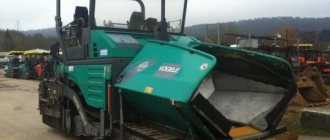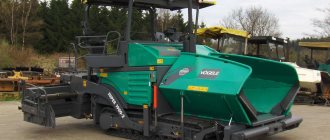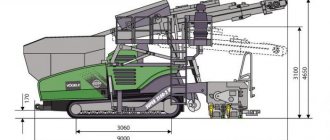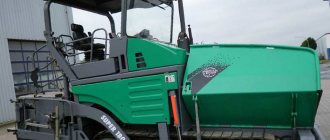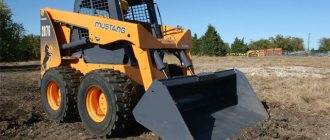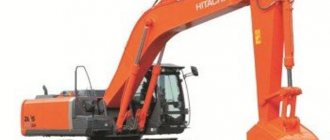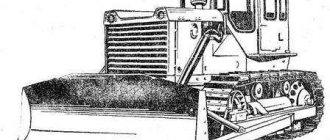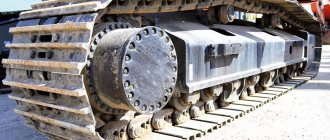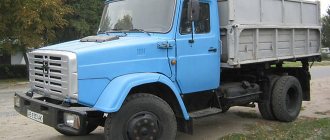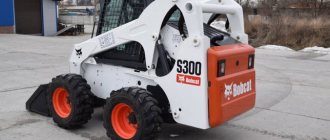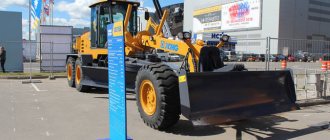The Vogele Super 1600 asphalt paver is a universal construction special equipment. It is capable of laying the mixture on highways, adjacent areas, sidewalks, highways, and streets. The machine is capable of not only laying the coating, but also evenly distributing the mixture over the base and compacting it.
Asphalt paver Vogele Super 1600-3
Navigation
- Features and Benefits
- Modifications
- Technical characteristics and dimensions
- Engine
- Devices for transporting and distributing mixtures
- Actuator
- Chassis
- Hydraulic system
- Operator's cabin
- Control system
- Ease of operation and maintenance
- Working bodies
- Cost of new and used
Return to navigation
Purpose and features of the machine
Vogele Super 1600-2 is a unit for universal use. Lays asphalt concrete pavement on sidewalks, streets, local areas, multi-lane highways and expressways.
Device Features:
- Crawler version of the propulsion unit.
- The working body of the machine comes in a variety of versions; road workers often buy a version with an electrically heated screed plate and a vibrating timber compacting device. It is possible to improve the parameters of mixture compaction using pressing bars.
- Smoothing plate with improved compaction. The delivery includes a set of extensions up to 6.5 m. Allows extension up to 8 m.
- Leveling the unit using the Nivelltronic Plus device.
- Control is carried out via the ERGO Plus system node.
- The application of lubricant is centralized to one mechanism.
- The width of the slab (2.5-5 m) is set by a hydraulic drive.
- When transporting the unit on a low-load ramp, it falls within the parameters of the overall load.
From the prepared review you will learn the technical characteristics of the Vogele Super 1800-2 asphalt paver, its cost, advantages and disadvantages.
And in this article we will talk about the DS-195 model.
This is interesting: Vogele SUPER 1800-2: characteristics, fuel consumption
Theoretical foundations of self-leveling of a floating working body
Using the above example of a paver moving over a wave-like unevenness on the surface of the base, the geometric pattern shown on the right can be obtained. When moving over a short uneven base of height H, the working body will rise only to a height h in a ratio equal to the ratio of the length b (the sum of the lengths of its support arm and the screeding plate of the working body) to the length of this plate. Since this ratio is usually approximately 5:1, the height of the remaining unevenness on the surface of the laid layer will be approximately 5 times less than the height of the unevenness of the base. Irregularities occupying a longer area can only be compensated by actively adjusting the position of the working element using leveling cylinders.
NOTEThe evenness should increase as each subsequent layer is laid and, accordingly, depends on the geometry of the underlying layer.
Features of special equipment
Understanding the prospects for the growth of road special equipment, the manufacturer began producing machines that were designed for large production capacities. Currently, there are several modifications of the Vogele 1600 asphalt paver:
- Series 1. It was put into production in 2003, the latest version rolled off the assembly line in 2007.
Asphalt paver Vogele 1600 version 1
- Series 2. Production began in 2006, it was an improved version of Series 1. Production ceased in 2014.
- Series 3. Modernized version of series 1 and 2. Currently in production.
Fundamental technical characteristics of the Vogele Super 1600 2 asphalt paver are designed to work not only on highways, but also for decorating the road surface on sidewalks, park paths, and local areas.
Asphalt paver Vogele 1600 2 versions
Basic technical data of the machine:
| Meaning | Parameter |
| Minimum width for installation | 2 meters |
| Maximum width for canvas design | 5 meters |
| Total weight, operational | 17800 kg |
| Motor series | PERKINS 1104C-E44TA |
| Power | 96 kW |
| Speed of laying asphalt with an asphalt paver | 24 meters per minute |
In general, the equipment is recognized as highly efficient, with the estimated productivity of the asphalt paver reaching 600 tons per hour.
Features of the structural part of the machine can be expressed by the following technological operating parameters:
- The propulsion unit has a caterpillar design.
- The common working body has different versions. Buyers can purchase equipment with various options. There is a version with electric heating for the screed platform of the work plate. In addition, there is a vibrating timber device for compaction. An optional installation with special strips designed for pressing is allowed.
- The plate, designed to smooth out the formation of a thick web, has improved compaction characteristics. The package includes an extender up to 6.5 meters long; it is possible to use an extender designed for a length of 8 meters.
- Comprehensive leveling is carried out by the Nivelltronic Plus auxiliary device.
- The system node is controlled using the comprehensive development ERGO Plus.
- The lubricant composition carries out the only type of centralized approach to the main mechanism.
- For a slab with a width of 2.0-2.5 meters, control is carried out by a hydraulic drive.
- Transportation of the unit on a low-loader platform of special equipment fits exactly within the overall dimensions of the machine.
Operating Parameters
| Engine | ||
| Powertrain Manufacturer | PERKINS | |
| Modification | 1104D-E44TA | |
| Power parameters at 2,000 rpm In economy mode | kW | 100 95 |
| Fuel tank | l | 300 |
| Electrical parameters | IN | 24 |
| Chassis | ||
| Belt track | 2 | With rubber shoes |
| Track support area | mm | 2 830x305 |
| Chassis drive | Independent hydraulic, electronically controlled | |
| Speed adjustable: | m/min km/h | during work: up to 24 during maneuvers: up to 4.5 |
| Feeder | ||
| Feeder drive type | 2 | Independent hydraulic |
| Conveyor device | 2 | Reversible, replaceable scrapers |
| Screw unit | 2 | Reversible, replaceable blades |
| Auger height adjustments | Standard: mechanical up to 14 cm Option: hydraulic up to 20 cm | |
| Bunker for receiving mixture | ||
| Holds | T | 13 |
| Width to dimensions | mm | 3 265 |
| Executive agency | ||
| Vibrating plate surface size: standard option exercise | m | From 2.55 to 5.0 From 3.0 to 6.0 |
| Layer depth | Up to 30 cm | |
| Heating the mixture | Electric heaters of rod design | |
| Electricity source | Generating device | |
| Width dimensions | m | 2,55 |
| Dimensions by length | m | During transportation: 6.0-6.1 |
| Weight | T | 18,4 |
Actuator
Fully hydrostatic with continuously variable torque settings. The gearbox of the pump group is assembled with a diesel unit and transmits rotational forces to the shafts of the hydraulic pumps of the units :
- track drives;
- both belt feeders;
- both screw units;
- working body height regulating mechanism;
- drive to the side walls of the bunker;
- unit for moving the executive body to the transport position;
- drives of timber compacting device and vibrating plate;
- drive bars for additional compaction.
Chassis
The caterpillar bogies are controlled by separate hydraulic drives through motor-wheels with sprockets.
Important! The working and transport modes are switched by an electrical circuit from the operator's cabin.
The belts are mounted from tracks with rubber shoes.
Sufficient lift and departure angles ensure independent loading of the unit onto the platform. The disc-type service brake and parking brake built into the motor wheels do not require adjustments or maintenance.
Steering
Maneuvering the unit is carried out by changing the track speed parameters. Movement control in the mixture laying mode is allowed using an electronic differential.
Mixture receiving hopper
Holds about 13 tons of asphalt concrete mixture. The sidewalls are tilted inward by hydraulic cylinders, ensuring full consumption of the working material.
Belt feeder
One hydraulic drive on both sides of the feeder. Changing the belt speed for manual adjustment of the mixture supply is carried out by an electrical circuit on a potentiometer, according to signals from mechanical sensors in automatic mode.
It is possible to adjust the movement of the belt at speeds from 0 to 25 m/min with the possibility of reverse. The bunker bottom sheets are secured with locks on the axles and are removed for replacement.
Screw distribution device
Separate hydraulic drives for rotation of both screw units. Control is stepless manual using an electrical circuit on a potentiometer or according to data from sensors from the auger chamber. The diameter of the blade part of the augers is 400 mm.
We reviewed the technical characteristics of the DZ-180 motor grader, which is an improved 143rd modification.
In this review, you will be interested to know the technical characteristics of the GS-14.02 motor grader.
The installation height of the auger device can be changed manually - with a spindle up to 140 mm, with optional hydraulic equipment - up to 200 mm. The unit allows reversible switching and height adjustment when installing expansion mechanisms and additional tunnel sheets.
Hydraulic system
The unit allows operation at plus 50 degrees Celsius. A large multi-section radiator device cools the engine oil, boost air, and hydraulic mixture.
The system is mounted on soft seals in the threads of the connections. It is possible to use an optional actuator with high mixture compaction without installing another pump. Convenient to maintain.
Digital Control System (DPC)
The system is assembled from electronic modules on a CAN-bus, which allows for instant diagnostics of the device.
The DPC software consists of:
- engine control algorithms (EM) - for its effective control, reduction of harmful emissions, fuel consumption;
- load limitation programs (ELC) – optimizes adjustments of hydraulic drives, eliminates overheating of the diesel engine and the executive body;
- traction force adjustment programs (TM) - changes the speed in the work cycle when moving straight and along a given trajectory curve;
- control systems control programs (TUSC) – connects remote control devices in the operator’s cabin and on the executive body;
- generator monitoring programs (GM) . It prevents generator current overload, regulates heating power, and optimizes equipment operation.
General lubrication system
It is installed as a standard device and centralizes the supply of lubricant to the bearings of parts in contact with the asphalt mixture. Lubricant consumption is controlled via the operator display.
Heating unit
Rod-type device with built-in heating elements with 18 kW power. The heating mode of the executive body is automatically changed to a clock (30 s) heating phase.
Leveling system
Supplied as a standard device and consisting of:
- Niveltronic Plus automation mechanism systems;
- sensors on the spindle, ski and probe;
- a sensor that controls tilt in the transverse axis;
- skis 2 and 7 m;
- devices for installing a tracing wire.
Control cabin
A reinforced fiberglass roof canopy is mounted on metal posts; the posts are covered with curtain curtains. To monitor the process, the driver's and operator's seats can be moved to the side behind the control platform.
The control unit moves in the required direction. All actuators are controlled from it, control information is displayed on the operating display.
General main switch
Simultaneously stops all components, mechanisms and functions of the machine, blocks the working element. When turned on, the parameters are completely restored and do not require adjustments.
Comparison of the operating principles of an asphalt paver and other construction machines
In principle , construction machines such as a bulldozer with a leveling blade, grader or asphalt paver can be used to distribute and level the laid material during road construction work.
Asphalt paver , however, due to its design features, is more preferable for laying asphalt concrete compared to a bulldozer and grader. Yes, in fact, it was created specifically for this job.
Bulldozer with a planning blade. Since the blade is rigidly connected to the chassis through a hydraulic cylinder, the unevenness moved by the machine is not only not leveled by it, but even increases. Since the blade is located a short distance in front of the crawler tracks, only short bumps are slightly leveled out.
The asphalt paver carries out the laying with its working body, which is freely hung on the base machine and therefore “floats” over the material being laid. Thanks to this, the working element very effectively smoothes out small irregularities on the surface of the material without sending control commands to it (self-leveling effect). A simple calculation (see Section 1.4) shows that, taking into account the length of the support arms on which the working element is hung on the base machine, when it is in floating mode, the height of short irregularities can be reduced by approximately five times.
Warehouse liquidation! Hurry up to pick up at purchase prices
Therefore, pavers should be used starting from the installation of the lower layers of road pavement, so that the evenness of each subsequent layer continuously increases.
Bulldozer with planning blade
The bulldozer blade, located in front of the tracked vehicles, is rigidly connected to the chassis by means of a clamping rod.
Therefore, the irregularities moved by the machine are reproduced by the blade not only without compensation, but even with an increase if the corresponding commands are not sent to the hydraulic cylinder.
Grader
The blade of this machine, located between the front axle and the rear wheeled bogie, is rigidly connected to the center beam by a hydraulic cylinder. If the appropriate commands are not sent to the hydraulic cylinder, the bumps being moved are cut off or filled to a height less than the height of the bump, i.e. the surface of a certain stele is leveled
Asphalt paver
Here the connection of the working body with the chassis is not rigid; the working body is supported at a certain height by the laid material, i.e. it “floats” on the surface of the logo material. Its penetration into the material under the influence of its own weight changes only by changing its angle relative to the direction of towing by the base machine - the “angle of attack”. If the paver moves over bumps, the height of the towing points of the working body and, consequently, its angle of attack changes. Accordingly, the height of the working body also changes, but is less than the height of the irregularities, i.e. they are leveled and smoothed out
Advantages and disadvantages of the model range
The machines of the SUPER Series model range are represented by 13 mechanisms. Tracked units operate with a productivity of 200-1,500 t/h, form strips from 1.8 to 16 m, the power plant produces power from 45 to 273 kW.
At the same time, the road surface is laid, distributed over the road surface and a mixture of asphalt and concrete is compacted on the bottom layer.
They differ from Russian units of the DS series:
- the presence of modern automated machine and work process control systems;
- better engineering solutions and technical performance;
- ease of maintenance and durability of use;
- operational efficiency;
- double the price per unit.
In 2015, during the construction of the Kemerovo-Novokuznetsk expressway in Kuzbass, the daily productivity of the Vogele Super 1600-2 asphalt paver when forming an 8-meter asphalt concrete strip was increased to 2 km.
And in this video we will be shown the principle of operation of an asphalt paver:
Application of asphalt pavers
Types of installation
Classic styling
Laying layers of multi-layer pavement on any roads and transport sites. These works can be performed on asphalt pavers of all sizes, with various working bodies. VOGELE asphalt pavers can lay layers from 2 to 40 cm thick.
Laying on a slope in the transverse direction
In addition to laying for normal road surfaces with possible uphill and downhill sections, asphalt pavers can also be used for laying on slopes and on the walls of landfills.
Typically, such work requires only minor modifications and alterations to the pavers. However, for very steep slopes, special pavers may be used that are technically specialized for such tasks.
Warehouse liquidation! Hurry up to pick up at purchase prices
Laying on a slope in the longitudinal direction
As an alternative to horizontal paving, asphalt pavers can also be used to work on slopes by laying the layer in the longitudinal direction of the slope. This requires only minor design modifications to the paver.
This laying method is often used in the construction of landfills and canals.
Construction of rutted roads and profiled surfaces
Special profiled coverings can be created using sliding working bodies, the geometry of which can be varied in a variety of ways.
A fracture of the main section of the working body allows the installation of a gable profile. Additionally, using the ability to change the height of individual elements of the sliding working body, it is possible to obtain M- and W-shaped profiles.
Using special formwork, it is possible to construct utility track roads and coverings with recesses for rail tracks.
The use of special formwork also allows installation on sharp turns, for example, during the construction of racing tracks.
Modifications
The asphalt paver has several generations:
- Vogele Super 1600-1 was put into production in 2003, the latest model was released in 2007.
- The Vogel 1600-2 was first released in 2006; after its release, production of the previous generation of machines ceased. Production of this model was stopped in 2014.
- The Vogele Super 1600-3 asphalt paver has become a modern successor to previous generations of construction equipment. Currently being released.
Return to navigation
This is interesting: Wirtgen W2000 road milling machine. Cold milling advantages and technical characteristics
Technical characteristics and dimensions
The high technical characteristics of the Vogele Super 1600 asphalt paver are inherent in all generations. Thanks to them, the technique has been particularly popular since 2003.
| Fuel tank | 300 l |
| Electrical system | 24 V |
| Performance | 600 t/h |
| Weight | 18.4 t |
Dimensions Vogele Super 1600-2
Return to navigation
Application of asphalt pavers
SprayJet and InLine Pave technologies
Asphalt paver Super 1800-2 with SprayJet module
Laying a thin layer of asphalt concrete on a hot binder is one of the most cost-effective methods for resurfacing pavements. However, such installation requires the use of special machines.
The SUPER 1800-2 asphalt paver with the SprayJet module sprays bitumen emulsion onto the old pavement and lays a new layer on it in one pass. Construction vehicles no longer need to drive around areas covered with emulsion, as the new asphalt concrete immediately covers it. In other words, an optimal layer of binder is created, which guarantees a reliable connection of the layers. In addition, this technology eliminates contamination of the road near the installation site, since cars no longer drive over the distributed binder.
SprayJet technology is also ideal for laying thin layers of sound-absorbing asphalt concrete. At the same time, in order to form noise-absorbing cavities in the layer, its material should not be compacted to the same extent as when laying a conventional mixture. The use of traditional technology with two working passes would worsen the quality of the laying, since the layers would then have to be thicker, which, with less compaction, would lead to a decrease in the load-bearing capacity of the pavement.
InLine Pave technologies
In accordance with InLine Pave technology, the layers of binder and coating are laid, like compacted asphalt concrete, using the “hot layer on hot” method in one working pass, thanks to which not only a very strong connection of the layers is achieved, but also their intensive adhesion. At the same time, VOGELE machines designed for two-layer installation using this technology can also be used for installation in the traditional way, i.e. their operation becomes more profitable.
Days of operation using InLine Pave technology require three machines: a MT 3000-2 Offset mix loader, SUPER 2100-2 IP pavers for laying the binder layer and SUPER 1600-2 or SUPER 1800-2 for laying the coating. They line up one after the other, almost right next to each other.
First on this construction train is the loader. It receives binder and coating mixtures from trucks and alternately transfers them to the large optional hopper of the SUPER 2100-2 IP or to a transfer module that dumps the coating mixture into the hopper of the SUPER 1600-2 ( SUPER 1800-2). The stacker, following the loader, applies the binder layer. This layer is immediately compacted to a high degree of compaction (final) and therefore has a high load-bearing capacity. To perform this task, the paver is equipped with a special high-compaction working body VOGELE AB 600 TP2 Plus. SUPER 1600-2 ( SUPER 1800-2), applies a coating layer to the binder laid in this way
Engine
The technical characteristics of the Vogele Super 1600 directly depend on the engine with which the machine is equipped. The first generation was equipped with a Deutz engine until 2003; subsequently, the asphalt paver was equipped with a Perkins engine.
The second generation is also equipped with a 100 kW, 4.4 liter Perkins diesel four-cylinder power unit. The standard equipment of the engine includes a direct fuel mixture supply system, turbocharging, intercooler, and liquid cooling system. Compression occurs in a ratio of 16.2/1.
The third generation is also equipped with four-cylinder engines, but manufactured by Cummins. The QSB 4.5 C155 model is characterized by a power of 116 kW and a rotation speed of 2000 rpm. Depending on the operating conditions, it switches to an economy mode, which reduces fuel consumption, and the power and rotation speed are reduced by 10 kW and 300 rpm, respectively. The power plant has Tier 3 and Stage 3a emission quality certificates. The fuel tank capacity is 300 liters. The fuel consumption of the third generation Vogele Super 1600 asphalt paver is 7.4 D (l/machine-hour).
| Vogele Super 1600-1 | Vogele Super 1600-2 | Vogele Super 1600-3 | |
| Manufacturer | Perkins | Perkins | Cummins |
| Model | 1104C-E44TA | 1104D-E44TA | QSB 4.5 C155 |
| Full power | 96 kW | 100 kW | 116 kW |
| Power measured at | 2000 rpm | 2000 rpm | 2000 rpm |
| Number of cylinders | 4 | 4 | 4 |
To maintain performance characteristics, the Vogele Super 1600-3 is equipped with a multi-section radiator, which guarantees maximum operating efficiency in all conditions.
A modern engine air cooling system allows you to maintain optimal temperature, which has a positive effect on the service life of the unit. The system includes a controllable fan and an improved air channel. Thanks to this system, the equipment can be used in any climatic conditions.
The EcoPlus system reduces exhaust pollutants, noise levels and fuel consumption.
Other features of the paver include:
- controlled fan. The boost speed depends on the operating climate and the load on the power plant. A hydraulic drive is installed, which creates less noise during operation and has increased efficiency;
- controlled cooling oil circuit. The hydraulic oil is heated by a thermostat to the required temperature in a matter of minutes, allowing you to start working almost immediately. As the temperature rises further, a valve opens to allow oil to pass through the radiator;
- automatic shutdown of pumps. When the machine is inactive, the hydraulic pumps are turned off, which allows you to reduce fuel consumption and start the power unit in conditions of negative temperatures.
Return to navigation
Main asphalt paver units
Asphalt pavers from VOGELE
Road pavers from VOGELE are designed both for laying all types of asphalt concrete mixtures and for laying subgrade materials. During asphalt concrete work, the asphalt concrete mixture unloaded from a dump truck is moved by scraper conveyors from the paver's receiving hopper to its working body, which, in fact, carries out the laying process. VOGELE asphalt pavers are distinguished above all by their high compaction, reliability, as well as ease of operation and maintenance.
1. Receiving hopper, thrust rollers
Dump trucks delivering the mixture unload it into a hopper located in front of the asphalt paver. In this case, in the process of transferring the mixture, the paver pushes the dump truck, resting against its wheels with its thrust rollers. Wide scraper conveyors transport the mixture through a tunnel running inside the paver to a screw chamber located in front of the working element. Equipped with a powerful engine, the paver can be mounted on either a wheeled or tracked undercarriage.
2. Scraper conveyors
Wide scraper conveyors transport the mixture through a tunnel running inside the paver to a screw chamber located in front of the working element.
3. Chassis
Equipped with a powerful engine, the paver can be mounted on either a wheeled or tracked undercarriage.
4. Distribution screws
The augers are designed to distribute evenly in front of the screed so that it can be laid with the required layer profile and compacted evenly. Therefore, the length of the augers must correspond to the layer width to which the working element is configured.
5. Working body
The working body of the asphalt paver is the very element that performs the task for which this machine was created. With its weight and the energy of its compacting units, it acts on the mixture, forming it into a layer of the required profile and pre-compacting it so that the layer can withstand the weight of the following roller, which performs the final compaction of the mixture.
6. Heaters
To prevent the mixture from sticking to the screed plates and compaction units (tamper and compaction strip (or strips)), they are heated during operation. Electric heater rods are used for this on UOCE1E pavers.
7. Leveling hydraulic cylinders
Unevenness of the base on which the new layer is laid is compensated by the asphalt pavers due to the fact that the angle of attack of the working body is accordingly adjusted by leveling hydraulic cylinders, which for this purpose change the height of the front ends of its supporting arms.
8. Hydraulic cylinder for unloading and blocking the working body
Depending on the operating conditions, the hydraulic cylinders for raising and lowering the working body change the pressure on it, unloading it to change the swimming parameters. When the cylinders are locked, the working element is blocked.
Devices for transporting and distributing mixtures
| Laying width when folded | 2550 mm |
| Maximum laying width | 8000 mm |
| Maximum coating thickness | 300 mm |
| Maximum laying speed | 24 m/min |
| Maximum travel speed | 4.5 km/h |
| Screw conveyor diameter | 400 mm |
Devices that distribute asphalt concrete in the auger chamber ensure its optimal level. Hydraulic motors of conveyor belts and high-power augers are designed to lay 600 tons of mixture per hour of operation.
The bunker for receiving asphalt concrete holds 13 tons of mixture, and due to the installation of movable sidewalls, its full use is achieved.
The belt feeder is equipped with hydraulic drives on the sides. The intensity of the belt movement is adjusted using an electrical circuit on a potentiometer. This allows the operator to independently monitor the amount of asphalt concrete supplied. Automatic control is based on the use of controllers. The belt can move at a speed of up to 25 m per minute with reverse motion. The bottom of the bunker is made of sheets, which are secured with locks on the pins. They are replaceable.
The auger distributor of the Vogele Super 1600 asphalt paver is equipped with hydraulic rotation drives. Control is carried out manually using an electrical circuit or controllers. The auger blades are 40 cm in diameter. The auger level is manually adjusted to 14 cm or 20 cm using a spindle and hydraulics respectively. Additional reverse and position adjustment are required when installing extensions.
The heating unit is a rod with 18 kW heaters. After the first heating of the actuator, the clock phase is activated (period of 30 seconds).
The leveling system is included in the basic assembly. Components:
- skis two and seven meters long, designed to be equipped with a carbon string;
- lateral axis deviation controller;
- controllers on the probe, ski and spindle;
- Niveltronic Plus system.
Return to navigation
Actuator
The power drive of the Vogel 1600 asphalt paver is installed of a hydrostatic type with smooth torque switching. The gearbox is designed to transmit rotational force to the shafts of hydraulic pumps. The work includes:
- hydraulic drive of optional slats, vibrating beams, plates, side walls of the bunker;
- node of the main organ;
- main body position regulator;
- screw distributor;
- belt feeders.
Return to navigation
Chassis
The caterpillar bogies are driven by hydraulic drives. Due to the impressive length of the running trolleys, an increased support area and maximum traction force are provided. This allows the Vogele Super 1600-2 paver to move at a constant speed under all conditions.
Stable movement without deviations, high maneuverability and other characteristics are due to the use of independent electrical control of the hydraulic motors of two track bogies. To change the operating mode, use a switch installed in the cab.
Vogele asphalt paver track
The maximum vehicle speed is 4.5 km/h.
The caterpillar track consists of tracks with rubberized shoes. To make it possible to independently enter and descend from the transport platform, a special design of the chassis is provided. The wheel motor is equipped with a disc brake system that does not require adjustment.
Return to navigation
The principle of operation of the floating working body
The asphalt paver differs from other construction machines in its floating working body. In this case, the thickness of the laid layer changes only by changing the angle of attack of the working body or the height of its towing points. Thanks to this, the irregularities over which the paver moves can be leveled without sending control commands to its working element, i.e. automatically, due to self-leveling.
unevenness of the roadbed is compensated by a self-leveling floating working element
When moving over longer unevenness, the height of the towing points of the floating working element automatically changes, which leads to a change in the thickness of the laid layer
Depending on the angle of attack, as a result of the forward movement of the paver, a corresponding amount of mixture falls under its working element. Therefore, over longer sections, the layer thickness changes harmoniously.
The reaction of the working body to changes in the geometry of the base depends on the following factors:
- travel speed
- changing the height of the towing points of the working body,
- properties of the mixture, such as compactability, load-bearing capacity.
Operator's cabin
The Vogele Super 1600 asphalt paver is equipped with an open cab. The racks are made of metal, and the covering is made of reinforced fiberglass. If necessary, curtains can be hung between the posts.
To ensure good visibility of the working platform, the driver's and operator's seats can be moved to the side. The driver monitors the condition of the machine, including the receiving hopper, working equipment, controllers and auger chamber. This allows you to fully control the amount of supplied mixture and asphalt concrete in the bunker.
Super 1600-3 open operator cabin
The instrument panel is adjustable. It moves to the side, rotates outward and has a variable slope.
To ensure safety and ease of access to the cabin, a convenient ladder and steps are provided.
Return to navigation

